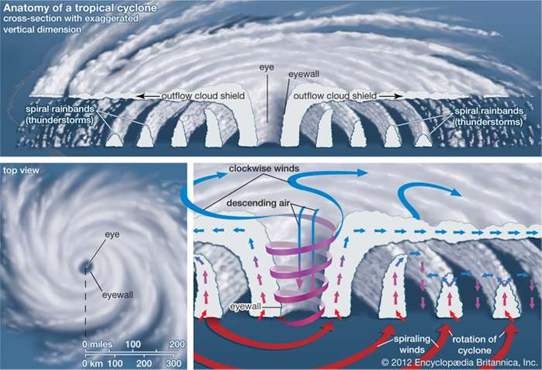

A tropical depression has formed in the North-east of Madagascar. According to current forecasts, this depression, named 'Herold', has a strong potential for development in tropical cyclones in the region.
Context
A tropical depression has formed in the North-east of Madagascar. According to current forecasts, this depression, named 'Herold', has a strong potential for development in tropical cyclones in the region.
About
- Tropical Cyclone Herold has developed close to Madagascar and is expected to strengthen further in the coming days as it heads into the southern India Ocean.
- Parts of Madagascar have already been hit by heavy rain.
- Reunion Island, and especially Mauritius (towards Rodrigues Island) are threatened.
- Location: Herold depression is currently located some 800 kilometres to the north-west of Port Louis in Mauritius.
- Intensity: It has sustained winds or about 110kmph (68mph) and gusts nearer 140kmph (87mph).
- The system is now intensifying explosively, with the winds forecast to reach 195kmph (120mph) gusting up to 240kmph (150mph).
- It is equivalent to a Category 3 Atlantic hurricane on the Saffir-Simpson scale.
- Impact: Widespread disruption, including the prospect of floods and mudslides, is likely.
- Movement: Strength of the storm and movement depends on favourable conditions in the warm waters. Conditions are extremely favourable as sea surface temperatures are about 28-29 degrees Celsius (82-84 degrees Fahrenheit).
- There is also very little vertical wind shear, which will allow Herold to remain upright and standing.
Tropical Cyclones
- Definition: A tropical cyclone is a rapidly rotating storm system characterized by a low-pressure centre, a closed low-level atmospheric circulation, strong winds, and a spiral arrangement of thunderstorms that produce heavy rain or squalls.
- Different names: Depending on its location and strength, a tropical cyclone is referred to by different names, including hurricane, typhoon, tropical storm, cyclonic storm, tropical depression, and simply cyclone.
- Hurricane: Atlantic Ocean
- Typhoon: North-western Pacific Ocean
- Tropical cyclones: South Pacific or the Indian Ocean
Mechanism of Tropical cyclones
- Movement: “Tropical” refers to the geographical origin of these systems, which form almost exclusively over tropical seas. "Cyclone" refers to their winds moving in a circle, whirling round their central clear eye, with their winds blowing counterclockwise in the Northern Hemisphere and clockwise in the Southern Hemisphere.
- The opposite direction of circulation is due to the Coriolis effect.
- Formation: Tropical cyclones typically form over large bodies of relatively warm water. They derive their energy through the evaporation of water from the ocean surface, which ultimately re-condenses into clouds and rain when moist air rises and cools to saturation.
- Tropical cyclones are typically between 100 and 2,000 km (62 and 1,243 mi) in diameter.
- Once the maximum wind speed exceeds 119 km (74 miles) per hour, the storm is classified as a tropical cyclone.
- The strong rotating winds of a tropical cyclone are a result of the conservation of angular momentum imparted by the Earth's rotation as air flows inwards toward the axis of rotation.
- Low surface: As a result, they rarely form within 5° of the equator.

The physical structure of Tropical cyclones
- Eye-wall: At the centre of a mature tropical cyclone, air sinks rather than rises, thereby creating a clear "eye".
- Weather in the eye is normally calm and free of clouds, although the sea may be extremely violent.
- Rain-bands: In addition to deep convective cells (compact regions of vertical air movement) surrounding the eye, there are often secondary cells arranged in bands around the centre.
- These bands, commonly called rain-bands, spiral into the centre of the storm.
- Outflow: The upper levels of a tropical cyclone feature winds headed away from the centre of the storm with anticyclonic rotation. Winds at the surface are strongly cyclonic, weaken with height, and eventually reverse themselves.
- Tropical cyclones owe this unique characteristic to the warm core at the centre of the storm.
- Area of influence: Tropical cyclones are almost unknown in South Atlantic due to consistently strong wind shear and a weak Inter-tropical Convergence Zone.
- The near-surface wind field of a tropical cyclone is characterized by air rotating rapidly around a centre of circulation.
- Once aloft, air flows away from the storm's centre, producing a shield of cirrus clouds. Typically, these are the highest and coldest clouds in the cyclone.
- They intensify very rapidly.
Impact of Tropical cyclones
- Since primary energy source for these storms is warm ocean waters, therefore they are typically strongest when over or near water, and weaken quite rapidly over land.
- Coastal regions are particularly vulnerable to the impact of a tropical cyclone, compared to inland regions.
- Coastal damage may be caused by strong winds and rain, high waves (due to winds), storm surges (due to wind and severe pressure changes), and the potential of spawning tornadoes.
- Tropical cyclones also draw in air from a large area—which can be a vast area for the most severe cyclones—and concentrate the precipitation of the water content in that air into a much smaller area.
- This continual replacement of moisture-bearing air by new moisture-bearing air after its moisture has fallen as rain may cause extremely heavy rain and river flooding up to 40 kilometres (25 mi) from the coastline.


